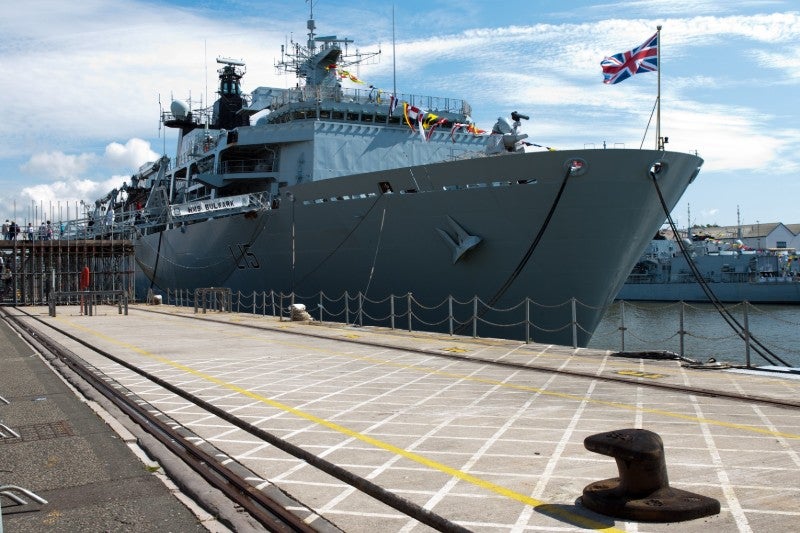
The Future Littoral Strike Ship (FLSS) concept announced earlier in 2019 forms part of the UK Government’s wider ambition to regain its global influence, effectively giving the Royal Navy forward-deployed assets with special forces and Royal Marine commandos onboard that can be maintained at very high readiness in case of emergencies or conflict. They will be able “to respond at a moment’s notice bringing the fight from sea to land”, noted Williamson in his February speech at the Royal United Services Institute.
That was echoed by the First Sea Lord, Admiral Sir Philip Jones, who noted that the FLSS would be a “valuable capability” to the Royal Navy and the Future Commando Force, providing range, mass, and lethality that can be projected from sea to land. This, he explained, would deliver “decisive military effect anywhere in the world, at a time of our choosing”.

Discover B2B Marketing That Performs
Combine business intelligence and editorial excellence to reach engaged professionals across 36 leading media platforms.
Initial details on the FLSS indicate that the vessels will form part of two Littoral Strike Groups, which will include escorts, support vessels, and helicopters. One of the groups will be based “East of Suez” in the Indo-Pacific region, and one “West of Suez” to support operations in the Mediterranean, Atlantic and the Baltic seas. The former is significant and in principle aims to reverse the decades of British global decline that began with the East of Suez withdrawal in the 1960s.
Secrecy surrounds the goal of a globally-responsive amphibious task force
In theory, the two FLSS would be able to link up with the two incoming Queen Elizabeth-class aircraft carriers, as well as the Royal Navy’s existing amphibious assault ships HMS Albion and Bulwark and three Bay-class landing ships, forming one large amphibious task force that is able to respond to global crises.
As is often the case with UK MOD announcements, however, actual details regarding programme cost and schedule are all shrouded in a cloud of secrecy and headline-grabbing buzzwords. The little detail that has been given indicates that the vessel’s development will be funded through the MOD’s Transformation Fund, but how much has already been spent, or is planned to be spent, has not been revealed. A key question remains, how will the Royal Navy afford two large new vessels, as well as the trained personnel required to man them and the support assets required to protect them?
There are elements that could save the Royal Navy money, including the utilisation of an ’off-the-shelf’ commercial vessel design rather than a bespoke naval vessel built to exacting military requirements. One company, Prevail Partners, has already put forward its Multi-Role Vessel solution for the FLSS requirement, with company sources noting that its solution is a “highly mobile logistic and helicopter base [that] enables nations to project power, carrying out the most time-sensitive special forces missions and managing threats at range with swift and decisive action”.

US Tariffs are shifting - will you react or anticipate?
Don’t let policy changes catch you off guard. Stay proactive with real-time data and expert analysis.
By GlobalDataReplicating US Special Forces and the MV Ocean Trader
Instead of the Royal Navy buying the vessels, Prevail says it would offer a “full turnkey solution” for over 300 operational days a year. This would be achieved through a wet-lease charter that means that “ownership of the vessel, raising and training its crew, technical management and all aspects of operating the core functions are delivered by Prevail and its partners”. Sources noted that a turnkey contract could see a FLSS become operational by 2020.
Computer generated images of the FLSS concept released by both Prevail and the Royal Navy bear striking similarities with the MV Ocean Trader vessel, a secretive cargo “mothership” vessel that was modified several years ago by the US Navy for use by US Special Forces. This unexciting sounding ‘Maritime Support Vessel’ is capable of embarking 200 special forces personnel, and has been modified to house manned and unmanned aviation assets in a hangar bay.
The Ocean Trader’s large deck allows aircraft such as Chinooks and Black Hawks to take-off and land, as well as the launch of drones that can perform intelligence gathering missions. Below deck, the vessels can also support cargo carrying and the offloading of vehicles while in port through a large stern ramp. Small boats are also able to be launched and recovered, supporting insertions of special forces units via the coast or waterways, as well as supporting boarding parties to storm other vessels.
The Royal Navy already has experience operating similar ships in the Point class of roll-on/roll-off (RO-RO) Strategic Sealift vessels, which share design aspects with the Ocean Trader. Six vessels (now reduced to four: Anvil Point, Hartland Point, Hurst Point, Eddystone) were acquired under a Private Finance Initiative in the 2000s and are operated privately by Foreland Shipping and crewed by Royal Navy Sponsored Reservists that could be called into government service at short notice to take part in sealift operations. When not in use, the vessels carry out regular cargo-carrying duties across the globe.
Devil in the details: an unclear acquisition strategy for a potentially formidable future
Working with Prevail Partners is Houlder, which designed and delivered this RO-RO solution and is now also working with the MOD as a technical advisor on the Type 31e Frigate. One potential option could also be to bring two of the Point–class vessels into full-time service with the necessary modifications to enable them to perform the planned functions of the FLSS. That would include a new flight deck and hangar, small craft launch and recovery systems, offloading vehicle capability via Mexeflote, self-defence weapons, a hospital ward, accommodation for embarked personnel, and command and control suites that include advanced encrypted communications.





